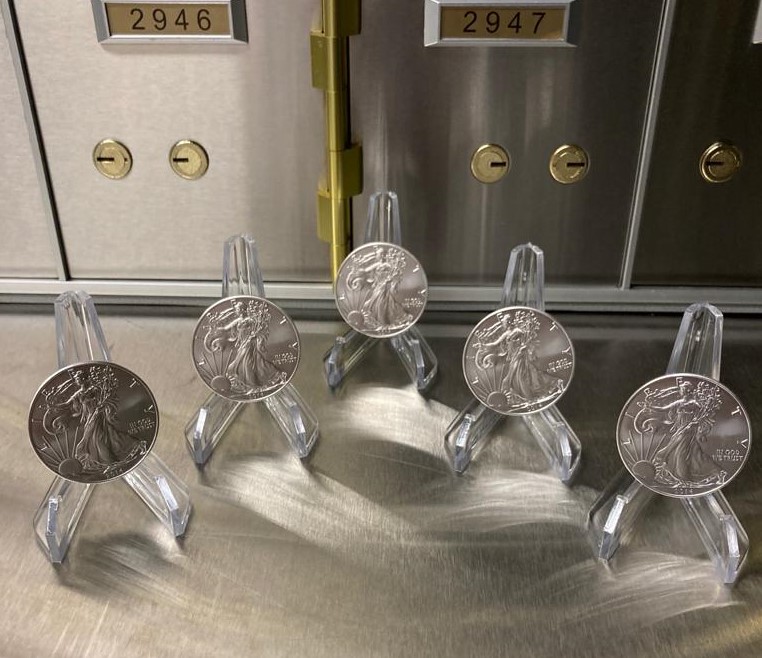
07/06/2024: This Week in Gold with Market Updates:
Price Action:
Gold:
Gold opened the week trading at $2,327 per ounce after closing the previous week 0.29% lower. Gold did not have much movement for the duration of the week, with most of the fluctuation in price coming in the last 2 days of the week, Thursday & Friday.
On Monday, gold opened at $2,327 per ounce and began the session by moving higher. Price gradually increased throughout the day, climbing $24 per ounce and closing the day 1.03% higher at $2,351. This contrasted a fall in both DXY and Treasury Yields.
On Tuesday, the gains that were observed in gold on Monday were reversed. Price steadily fell throughout the day, falling a total of $24, and closing at Monday’s open of $2,327 per ounce. Again, gold’s moves contrasted that of the DXY and Treasury Yields, which experienced a steady increase in price.
On Wednesday, gold moved 1.2% higher. Price continued its trend of moving sideways for the week, making no distinct move higher or lower. Gold ultimately closed at $2,355 per ounce.
On Thursday, gold made a noticeable move higher after it was announced that the ECB would be cutting rates by 25 basis points to 3.75%. Price moved as much as 0.5% in 2 hours, before the move slowed and gold began to consolidate to close out the day. Price ultimately closed at $2,376 per ounce, which was a 0.89% rise from the open.
On Friday, price quickly began to move lower. With a sharply rising DXY and sharply rising Treasury Yields, gold’s losses were exemplified. Gold fell 2.8% by 1pm, signalling a sharp selloff in precious metals. At the time of writing, gold is trading at $2,307 per ounce and is on track to move 0.8% lower.
Silver:
Silver opened the week trading at $30.41 per ounce after closing the previous week 0.14% higher. Silver is on track to close the week slightly lower this week and price followed similar movements to gold throughout the week.
Silver had a mixed week, closing higher 3 times, and on track to close lower twice. At the time of writing, silver is currently trading at $29.35 per ounce, meaning it is on track to close the week 3.49% lower.
Market Updates:
20/05/2024: U.S. Manufacturing PMI
- U.S. Manufacturing PMI:
On Monday, the U.S. Manufacturing PMI was released, showing a figure of 51.3, higher than the expected 50.9 and the previous month’s 50. The Manufacturing Purchasing Managers’ Index (PMI) is a key economic indicator derived from monthly surveys of private sector companies, providing insight into business conditions in the manufacturing sector. A PMI reading above 50 indicates expansion, while a reading below 50 indicates contraction.
The better-than-expected PMI indicates expansion in the manufacturing sector, suggesting increased economic activity and potential growth. For gold and silver markets, a strong manufacturing PMI can have mixed implications. It signals economic strength, which can reduce demand for safe-haven assets like gold and silver.
21/05/2024: JOLTS Job Opening
- JOLTS Job Openings:
Tuesday’s JOLTS (Job Openings and Labor Turnover Survey) data showed that job openings in the U.S. came in at 8.06 million, lower than the expected 8.37 million and the previous month’s 8.36 million. The JOLTS report is a measure of job vacancies, providing insight into labor market conditions.
The decline in job openings suggests a cooling labor market, which could signal slower economic growth ahead. This may increase demand for gold and silver as safe-haven assets, as investors might seek protection against potential economic downturns.
22/05/2024: EU and U.K. Purchasing Managers Index (PMI):
- EU Composite PMI and Services PMI:
On Wednesday, the EU Composite PMI came in at 52.2, slightly below the expected 52.3 but higher than the previous month’s 51.7. The EU Services PMI was reported at 53.2, just below the expected 53.3 and unchanged from the previous month.
These figures indicate a moderate expansion in both the manufacturing and services sectors within the Eurozone. For gold and silver markets, steady economic growth in the EU can reduce immediate safe-haven demand. However, continued economic expansion could lead to inflationary pressures, providing some support for precious metals.
- U.K. Composite PMI and Services PMI:
The U.K. Composite PMI was reported at 53, slightly above the expected 52.8 but down from the previous month’s 54.1. The U.K. Services PMI came in at 52.9, in line with expectations but lower than the previous month’s 55.
The mixed PMI data from the U.K. indicates steady but slowing growth in the economy. This may lead to cautious sentiment among investors, potentially supporting gold and silver prices as hedges against economic uncertainty.
23/05/2024: ECB Interest Rate Decision and U.S. Initial Jobless Claims:
- ECB Interest Rate Decision:
The European Central Bank (ECB) lowered its main interest rate to 3.75% from 4%, in line with expectations. The interest rate decision is a critical tool for central banks to influence economic activity, with lower rates typically aimed at stimulating growth.
The ECB’s decision to cut rates reflects concerns about economic growth in the Eurozone. Lower interest rates can lead to a weaker euro, potentially increasing the appeal of gold and silver as alternative stores of value. Additionally, lower rates can increase inflationary pressures, which can also support demand for precious metals as hedges against inflation.
- U.S. Initial Jobless Claims:
U.S. Initial Jobless Claims came in at 229,000, higher than the expected 220,000 and the previous week’s 221,000. Initial jobless claims are a measure of the number of people filing for unemployment benefits for the first time, indicating labor market conditions.
The higher-than-expected jobless claims suggest some softening in the labor market, which can increase economic uncertainty and support demand for gold and silver as safe-haven assets. However, if the labor market remains relatively strong overall, the impact on precious metals may be limited.
24/05/2024: U.S. Non-Farm Payrolls (NFP):
- U.S. NFP:
Friday’s Non-Farm Payrolls (NFP) report showed a strong increase of 272,000 jobs, significantly higher than the expected 182,000 and the previous month’s 175,000. The NFP report is a key indicator of labor market health and economic activity.
The robust job growth suggests a strong labor market and economic expansion. For gold and silver markets, this could reduce safe-haven demand as investors feel more confident in the economy.
